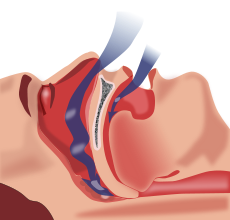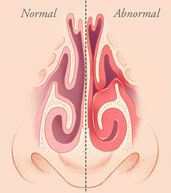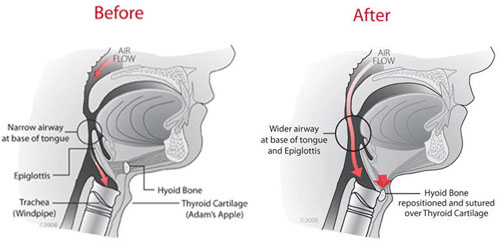Snoring and Obstructive Sleep Apnea

Snoring is a sound produced by vibration of the soft tissues of the upper airway during sleep and is indicative of increased upper airway resistance. Studies estimate that 45% of men and 30% of women snore on a regular basis. It can affect not only the snorer’s sleep but also the sleep of a spouse or other family members nearby. In fact, snoring causes many couples to sleep in separate rooms and often places strain on marriages and relationships. Recent evidence suggests that snoring may even cause thickening of the carotid arteries over time and potentially increase risk of stroke.
45% of normal adults snore at least occasionally and 25% are habitual snorers. Problem snoring is more frequent in males and overweight people and usually worsens with age. Snoring may also be a sign of a more serious health condition known as obstructive sleep apnea (OSA), characterized by a repetitive stopping or slowing of breathing that can occur several times throughout the night. Most patients who snore should receive a comprehensive sleep evaluation, which often includes sleep testing either done at home or in a sleep laboratory.
The board-certified surgeons at New England ENT offer the latest in office treatments and surgical procedures to address obstructive breathing symptoms.
What causes snoring?
Snoring is the noise produced by the obstruction of airflow through the passages at the back of the mouth and nose. This area is the collapsible part of the airway where the tongue and upper throat meet the soft palate and uvula. Snoring occurs when these structures strike each other and vibrate during breathing. Snoring can be exacerbated by nasal obstruction from allergies, upper respiratory infections, or anatomical variants such as a deviated septum or enlarged inferior turbinates. These problems can cause turbulent airflow, which is more likely to cause vibration of the tissues in the throat. In fact, studies have shown that nasal surgery alone (for patients with deviated nasal septum or enlarged inferior turbinates) can improve snoring by 60-80%.
In children, snoring may be a sign of problems with the tonsils and adenoids. Please refer to Snoring & Sleep Disordered Breathing in Pediatric Services for more information with regards to this.

People who snore may suffer from:
- Poor muscle tone in the tongue and throat: When muscles are too relaxed, the tongue falls backwards into the airway or the throat muscles draw in from the sides into the airway. Some relaxation is natural during deep sleep, but may become a problem if exacerbated by alcohol or drugs that cause sleepiness
- Excessive bulk of tissue in the throat: Children with large tonsils and adenoids often snore. Overweight people may have excess soft tissue in the neck that can lead to airway narrowing. Cysts or tumors are rare causes of airway narrowing.
- Elongated and posteriorly displaced soft palate and/or uvula: A long palate narrows the opening from the nose into the throat. The excessive length of the soft palate and/or uvula acts as a noisy flutter valve during relaxed breathing.
- Obstructed nasal passages: A stuffy or blocked nose requires extra effort to pull air through it. This creates an exaggerated vacuum in the throat that pulls together the floppy tissues of the throat, and snoring results. In some patients snoring may only occur during the hay fever season or with a cold or sinus infection. Also, deformities of the nose or nasal septum, such as a deviated septum (a deformity of the wall that separates one nostril from the other) can cause such an obstruction.

Why is snoring serious?
Socially – Snoring can make the snorer an object of ridicule and can cause the bed partner to experience sleepless nights and fatigue.
Medically – It disturbs sleeping patterns and deprives the snorer of adequate rest. It may be also a sign of obstructive sleep apnea (OSA), which can lead to serious, long-term health problems.
What is obstructive sleep apnea?
Snoring may be a sign of a more serious condition known as obstructive sleep apnea (OSA). OSA is characterized by multiple episodes of breathing pauses greater than 10 seconds at a time, due to upper airway narrowing or collapse. This results in lower amounts of oxygen in the blood, which causes the heart to work harder. It also causes disruption of the natural sleep cycle, which makes people feel poorly rested despite adequate time in bed. Apnea patients may experience 10 to 300 such events per night.
The immediate effect of sleep apnea is that the snorer sleeps lightly and keeps the throat muscles tense in order to maintain airflow to the lungs. Because the snorer does not get a good rest, he or she may be sleepy during the day, which impairs job performance and makes him or her a hazardous driver or equipment operator. Untreated obstructive sleep apnea increases the risk of developing heart attacks, strokes, diabetes, and many other medical problems.

How is heavy snoring evaluated?
Heavy snorers should seek medical advice to ensure that sleep apnea is not a problem. Heavy snorers include people who snore constantly in any position or who negatively impact a bed partner’s sleep. The providers at New England ENT offer a detailed upper airway assessment to identify the levels of airway obstruction. An examination can reveal if the snoring is caused by nasal allergy, infection, nasal obstruction, obstruction behind the palate or tongue, or enlargement of the tonsils and adenoids. A sleep study in a laboratory or at home may be necessary to determine if snoring is due to OSA.
All snorers with any of the following symptoms should be evaluated for possible obstructive sleep apnea:
- Witnessed episodes of breathing pauses or apnea during sleep
- Daytime sleepiness or fatigue
- High blood pressure
- Heart disease
- History of a stroke
What treatments are available?
Treatment depends on the diagnosis and level(s) of upper airway obstruction. In some cases, more than one area may be involved. Snoring or OSA may respond to various treatments outlined below (either alone or in combination):
- Obstructive sleep apnea is most often treated with a device that opens the airway with a small amount of positive pressure. This pressure is delivered via a nasal mask worn during sleep. This treatment is called CPAP; it is currently the initial treatment of choice for patients with OSA.
- Uvulopalatopharyngoplasty (UPPP) is surgery for treating snoring and obstructive sleep apnea. It removes excess soft palate tissue and opens the airway. In addition, the remaining tissue stiffens as it heals, thereby minimizing tissue vibration. The size of the air passage may be further enlarged when a tonsillectomy is added to the procedure.
- Thermal ablation procedures reduce tissue bulk in the nasal turbinates, tongue base, and/or soft palate. These procedures are used for both snoring and OSA. Different methods of thermal ablation include bipolar cautery, laser, and radiofrequency. These procedures may be done in the operating room or during an office visit. Several treatments may be required.
- Genioglossus and hyoid advancement is a surgical procedure to minimize the collapse of the lower throat by pulling the tongue muscles forward, thereby opening the obstructed airway.
- A custom-fit oral appliance, which repositions the lower jaw forward, may also be considered for certain patients with snoring/ OSA. These appliances are typically fitted by an oral surgeon, with expertise in sleep dentistry.
- Overweight patients can improve the severity of snoring and OSA with significant weight loss.
Do you recommend the use of over-the-counter devices?
There is no specific device recommended. More than 300 devices are registered in the U.S. Patent and Trademark Office as cures for snoring. Different methods include products that help a person avoid sleeping on their back, since snoring is often worse in that position. Some devices open nasal air passages; others have been designed to condition a person not to snore by producing unpleasant stimuli when snoring occurs. While a person may find a product that works for him or her, underlying poor sleep quality may remain.

Self-help for the light snorer
Adults who suffer from mild or occasional snoring should try the following self-help remedies:
- Adopt a healthy and athletic lifestyle to develop good muscle tone and lose weight.
- Avoid tranquilizers, sleeping pills, and antihistamines before bedtime.
- Avoid alcohol for at least four hours and heavy meals or snacks for three hours before retiring.
- Establish regular sleeping patterns
- Sleep on your side rather than your back.
- Elevate the head of your bed four inches.
